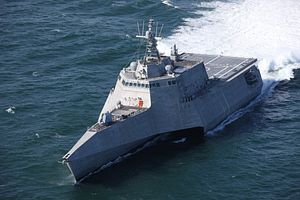The U.S. Navy’s latest Littoral Combat Ship (LCS), the future USS Charleston, successfully completed acceptance trials in the Gulf of Mexico on July 19 Naval Sea Systems Command (NAVSEA) said in a statement.
The acceptance trials, which included a series of a series of in-port and underway demonstrations, were overseen by the U.S. Navy’s Board of Inspection and Survey, the U.S. Navy’s main organization inspecting and reporting on a warship’s readiness for active duty operations.
“Acceptance trials are the last significant milestone before the ship is delivered to the Navy,” NAVSEA said in the statement. “During trials, the Navy conducted comprehensive tests of the future USS Charleston to demonstrate the performance of the propulsion plant, ship handling abilities and auxiliary systems.”
LCS is divided into two separate classes, the Independence and Freedom variants. Construction of the Freedom-class is spearheaded by Lockheed Martin at Fincantieri Marinette Marine shipyard in Wisconsin, while the building of Independence-class is directed by Austal USA in Alabama. Contracts for twenty-nine LCS have been awarded to the two U.S. shipbuilders to date.
The future USS Charleston is the ninth Independence-class variant built by Austal USA and the third delivered to the U.S. Navy in 2018. “As we continue to grow to a 355 ship Navy, I am confident these small surface combatants will continue to contribute to the distributed lethality of our nation’s global force structure,” Austal USA President Craig Perciavalle said in an August 3 press release. As I noted earlier this year:
Independence-class LCS feature a trimaran hull and a larger flight deck than the Freedom-variant design, enabling Independence-class ships of this particular variant to carry two rather than one SH-60 Seahawk helicopter, or one larger Ch-53 Sea Stallion helicopter, next to a number of unmanned aerial vehicles. Furthermore, the Independence-class also has a larger fuel capacity and a wider operational range.
Furthermore, I explained:
Using an open architecture design, both LCS classes — the mono-hull Freedom and trimaran-hull Independence variants — are modular, reconfigurable warships that can be fitted with interchangeable mission packages providing specific capabilities for surface warfare (SUW), anti-submarine warfare (ASW), and mine countermeasures (MCM) missions in the littoral region.
Yet while LCS of both variants are fitted with a 11-cell Raytheon RIM-116B SeaRAM missile-defense system and one 57-millimeter naval gun, as well in the near future with AGM-114 L Hellfire missiles and Mark 5o torpedoes, the ships of the class were not designed for naval warfare and there has been considerable doubt as to their ability to fulfill their mission requirements.
To further boost LCS firepower, the warships are also expected to be armed with a new long-range, anti-ship missile (the fifth-generation over-the-horizon Naval Strike Missile) to implement a re-organization of the surface fleet based on the ‘distributed lethality’ concept of operations, as well as anti-ship missiles such as the RGM-84D Harpoon Block 1C.

































